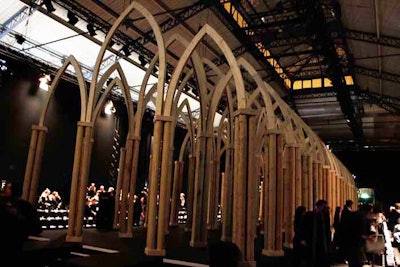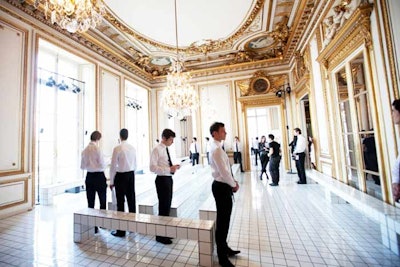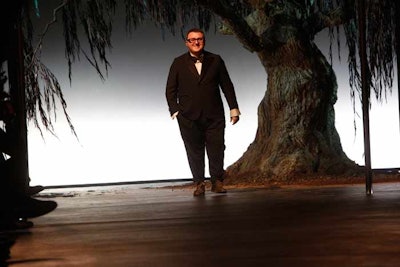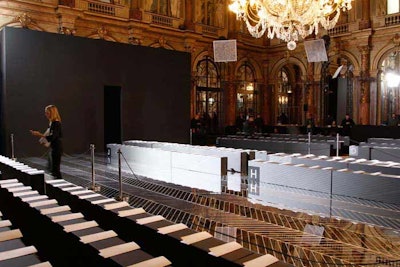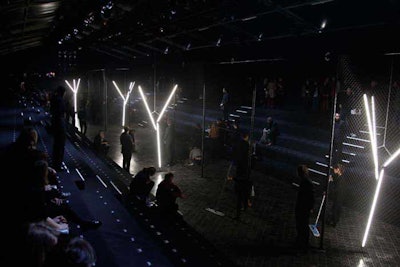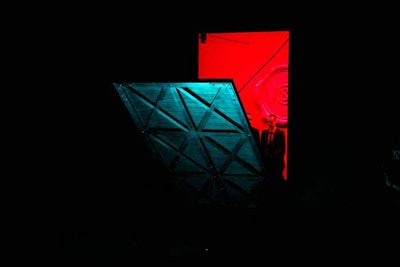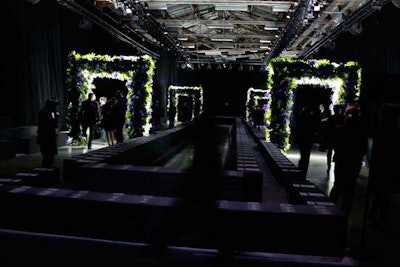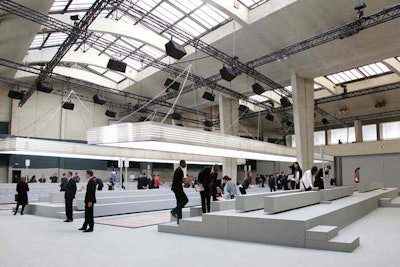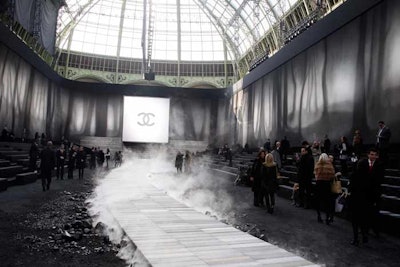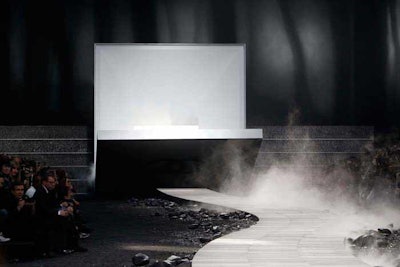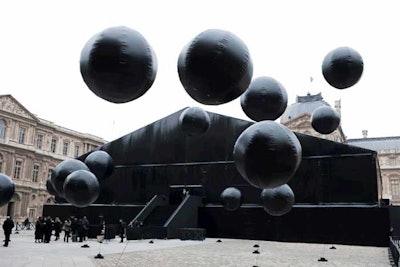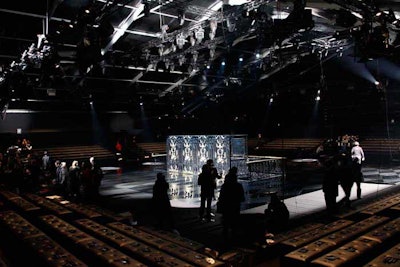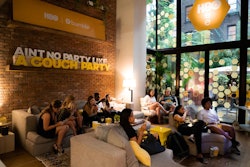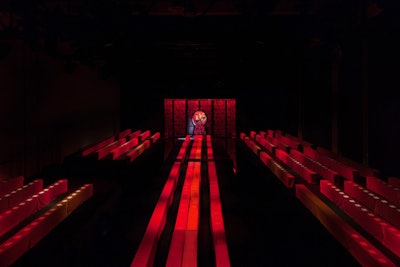
Diane von Furstenberg went dark for fall, enlisting Bureau Betak to create a set for her February 15 show at Spring Studios that was moody and reflective of the collection's boudoir-esque feel. "By day she commands her world; by night she inspires fantasy," is how the designer put it. Translated, most saw some sort of Fifty Shades of Grey meets, thanks to the large doses of red, a Chinese New Year celebration, all wrapped into one.
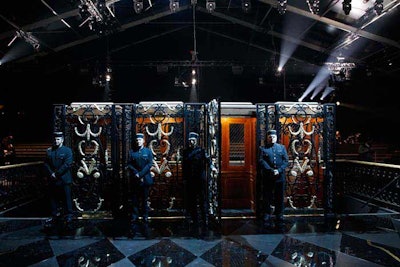
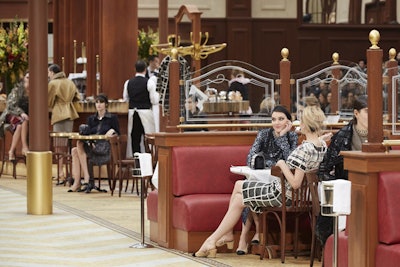
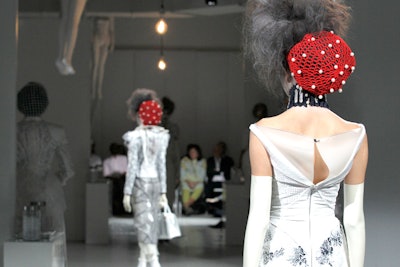
Also held at Center548, Thom Browne’s September 9 show was a lesson in patience and sanity. As guests waited a solid 50 minutes, they were subjected to music-box tinkling in a venue that had been transformed with white padded walls and flickering lights. White female body casts made of plaster gauze hung from the ceiling and positioned around the room created an eerie surreal effect. All in all, it was a true insane asylum experience.
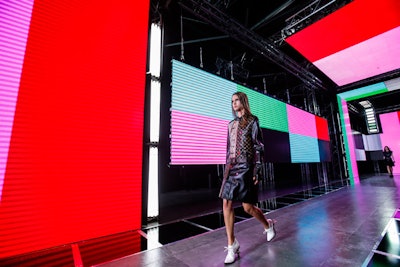
Held at the Fondation Louis Vuitton on the outskirts of Paris, the Louis Vuitton show took guests on a journey to the digital frontier. The mega black-box structure erected and set up with an enormous video installation was intended to drive home the point of Vuitton's digital-age ascendancy.
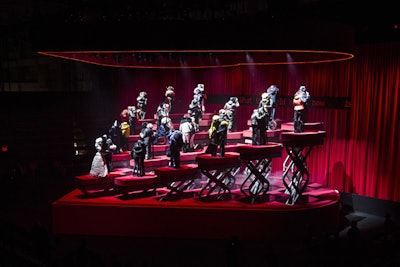
Utilizing a timed hydraulic system, organizers propelled each couple, portraying a different winter sport discipline, via a dedicated piston—all the while ensuring the overarching formation of a heart was uninterrupted. The show was set to "Hymne à l'amour," a popular love song originally performed by Edith Piaf.
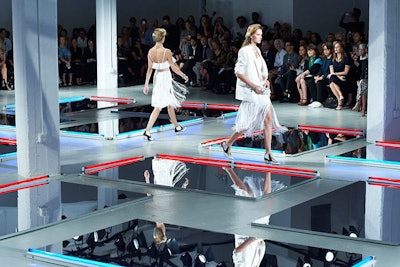
Produced and designed by Bureau Betak, Rodarte's September 11 show at Center548 featured a striking grid of mirrors with red and blue fluorescent tubes (now a Rodarte signature), inspired by Los Angeles’s street grid at night in the '80s. A continuation of its fall collection’s Northern California roots, the West Coast homage further showcases L.A. as a hotbed for talent, as spearheaded by Hedi Slimane.
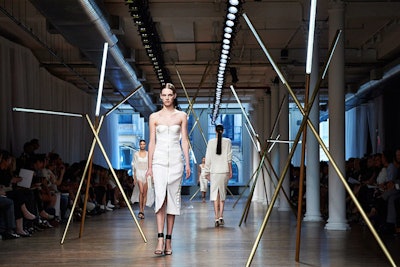
Opting for a more austere and minimal backdrop for his September 6 show at 82 Mercer, Jason Wu worked with Alex de Betak to devise a landscape light show that ran the entire length of the runway. Eight brushed brass light sculptures that emitted a severe white LED light, custom made by show producer and designer Bureau Betak, complemented Wu’s color palette of sandy neutrals infused with gentle shots of color.
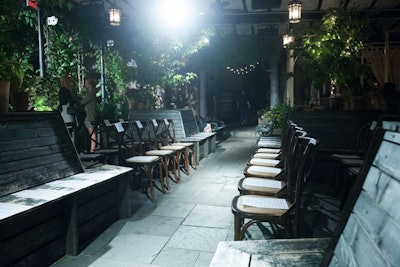
Gallow Green, the alfresco rooftop space atop the McKittrick Hotel, served as the venue for Billy Reid’s charming September 6 men’s show. The rough-hewn garden-cum-abandoned rail yard was an ideal backdrop to the designer’s Southern prep-meets-surf lineup. In a novel twist, a stretch of on-site railroad track, covered in lush greenery, served as the main runway for photographers.
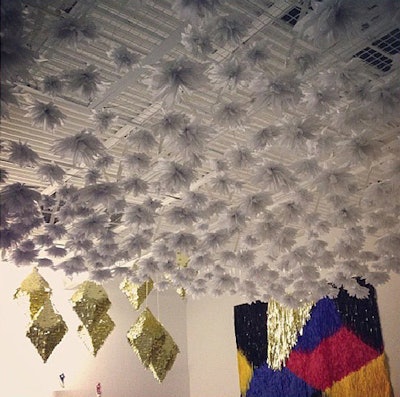
Converse celebrated its newest collaboration—this time with Paris-based fashion house Maison Martin Margiela—with a party at the blank canvas Swiss Institute in SoHo that coupled the avant-garde with classic Americana. Produced by Black Frame, the creative vision of the September 11 launch was around the notion of “reveal,” which collectively served as the evening’s centerpiece—also tying in elements from Confetti System to create bespoke elements like piñatas and a 14- by 15-foot fringe backdrop celebrating the collection’s youthful spirit. The producers also built one entire wall in order to create craters from which sneakers seemed to “explode."
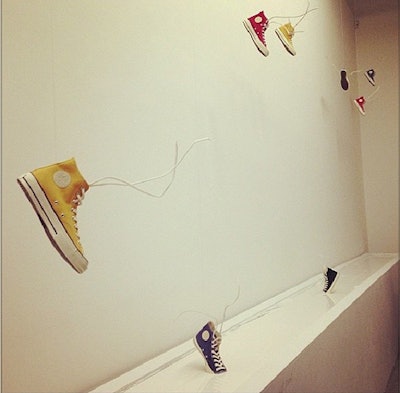
Also creatively done was a large-scale installation whereby a dozen or so classic Converse sneakers were hung by fish line at varying heights—some with toes dipped into a stream of white paint than ran along the wall.
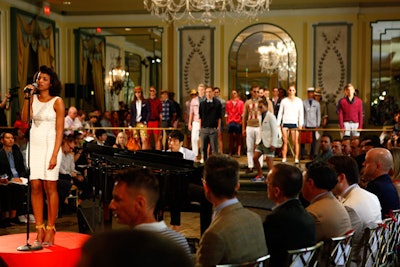
From the invitation to the Pierre hotel show venue, Michael Bastian’s spring collection, shown on September 6, indicated a certain French je ne sais quoi this season. So, although stunning, it was no surprise to enter one of the hotel’s ballrooms to see a grand piano and 220 gilded chairs lined up in half-circular layers. Produced by Stefan Campbell with front of house managed by the Eighth Floor, Bastian’s luxurious event saw a performance by pianist Borahm Lee and accompanying singer Alice Smith.
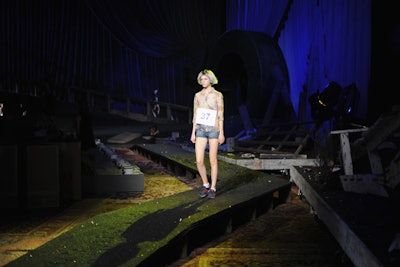
Tasked with realizing Marc Jacobs’s vision of “Victorian surf,” longtime set designer Stefan Beckman devised an abstract beach at the 69th Regiment Armory on September 10 that melded visual cues ranging from the Paul McCartney show at the Park Avenue Armory to Burning Man in Nevada to the notion of artifice. Fully immersing the audience into the runway—a series of six concentric circular islands were built so editors would feel “washed up”—the weeklong load in marked the first time Jacobs had utilized all 25,000 square feet of the venue for a show.
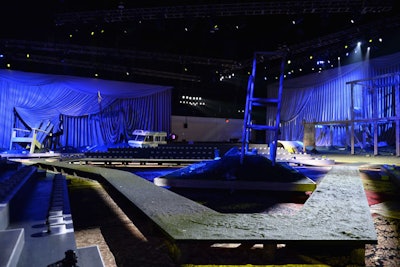
Meandering paths covered with seven tons of coal slag snaked around the entire space of the Marc Jacobs show, with Kadan Productions culling 5,600 yards of fabric for the theatrical stage curtains for an air of opulence. Creative Engineering built the giant props.
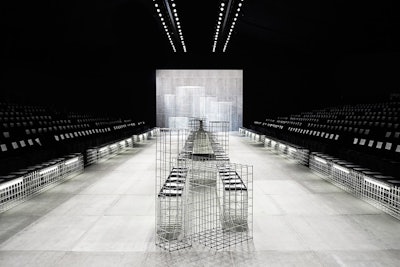
For designer Felipe Oliveira Baptista, the simple lines of a tennis court not only inspired the designs he showed for spring, but also the atmosphere of his September 7 show. Held in the Mercedes-Benz Fashion Week tents at Lincoln Center, the runway backdrop included a series of strategically placed all-white metal tennis nets, which also ran the length of the runway interspersed between guest seating areas.
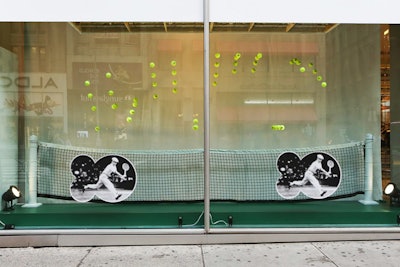
With its 80th birthday on the calendar, Lacoste celebrated the anniversary with a Fifth Avenue flagship window display that continued the fashion show theme of touting a modern take on its heritage. Produced by M Crown Productions, one dedicated interactive window featured kinetic and sound vibration technology where people walking past the window would set off a sensor, triggering a soundtrack of a tennis match and literally affecting the motion of the tennis balls. United Kingdom-based company Feonic was enlisted to provide its device that sticks to the window glass and transmits sound via waves, thus eliminating wires and speakers. A behind-the-scenes look at the making of the windows can be found here.
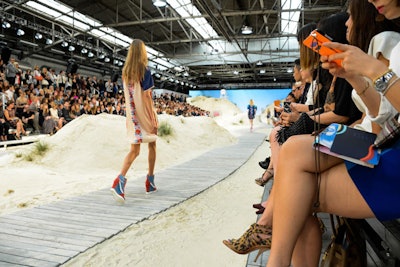
In keeping with the spring collection’s “California style—Melrose to Malibu” theme, the September 9 Tommy Hilfiger show at Pier 94 featured a 390-foot-long weathered wooden boardwalk-cum-runway that was flanked by 140 tons of sand trucked in from Long Beach Island, New Jersey. Produced by KCD, the foundation of the expansive set was constructed primarily of steel decking and then covered in sand. Guests sat on metal bleachers, with mountainous dunes appearing at the far end of the runway, along with surfboards propped up for effect.
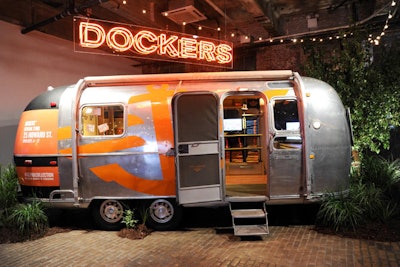
For the Dockers Alpha Collection party held at the start of New York Fashion Week on September 5, BMF Media managing creative director Nicky Balestrieri turned the Highline Stages venue in the meatpacking district into a slice of “cool San Francisco” as a nod to the brand’s roots. A classic Airstream trailer, filled with Dockers pants, sat in one corner while nautical dock ropes lined the guest check-in area. The stage and bar were fashioned from reclaimed wood. Food was also served in a festive manner, with a wheelbarrow full of oysters and a foldout accordion that held a 16-foot-long sushi roll held up by three waiters.
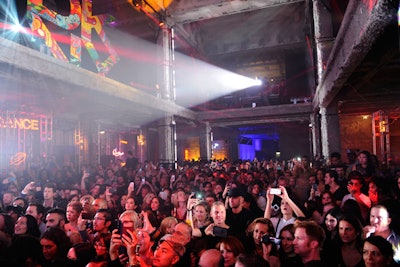
To celebrate its 25th anniversary, DKNY hosted something of a rager on September 9 at 23 Wall Street. The event featured live performances by Rita Ora, Iggy Azalea, A$AP Rocky, and A$AP Ferg.
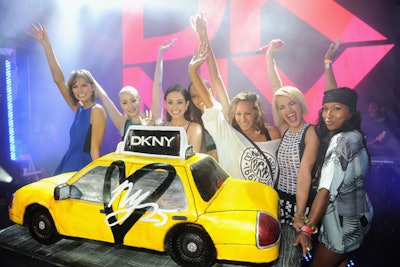
The DKNY's bash, produced by One Kick L.L.C., was filled to capacity with several hundred guests. At the end of the night, emcees Karlie Kloss and Joan Smalls presented a larger-than-life DKNY birthday cake in the shape of an iconic New York City taxicab to Donna Karan while Ora and Melanie Fiona sang “Happy Birthday.” DJ sets by Sinatria and May Kwok had guests dancing late into the night.
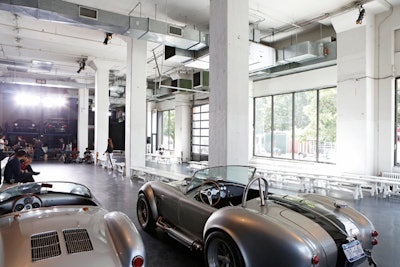
Held within the intimate confines of the Classic Car Club on Hudson Street, General Idea's September 6 show cleared all but two of the venue’s antique roadsters that set the tone for the label’s sleek and sportive separates. General Idea designer Choi Bumsuk, however, wasn’t the only one who was bit by the auto bug during Fashion Week; Siki Im’s show on September 9 featured Range Rovers and BMWs that lined the grit-covered brick walls of Pier 57.

For Opening Ceremony’s first-ever fashion show, held September 8 at the SuperPier off the West Side Highway (a.k.a. Pier 57), producer HK Media Group brought in 20 exotic sports cars from Broadway Supercars and staged their entrance with 34 female and 20 male models. The models were in the cars as they drove onto the massive show space—directly adjacent to where Opening Ceremony launched its “BTW” pop-up market—an homage to New York, where the company was born, but also a nod to the street racing culture of the co-founders’s Los Angeles roots.
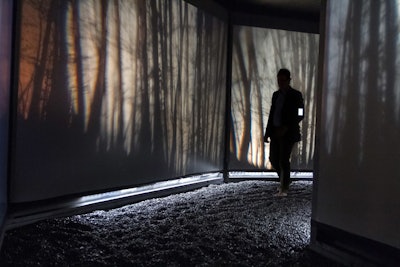
Nike erected a three-day installation in Gansevoort Plaza during Fashion Week to celebrate the launch of its Nike Free Hyperfeel running shoe. Produced by Aramique Krauthamer, founder of production company Odd Division, which specializes in interactive and immersive media, and Web and installation creator Jeff Crouse, the black-on-black temporary structure featured a tactile labyrinth comprising barefoot experiences that amplified nature. Three distinct physical spaces made up the labyrinth, which replicated common running surfaces like stone, sand, and grass. Equipped with neuro-headsets, visitors produced their own audiovisual installation—informed in real time by the brain's sensory reaction to the textures underfoot.

Guests arriving at the January 27 Chanel haute couture show were met by a gigantic circular white garden installed beneath the dome of the Grand Palais in Paris. Designated entrances were built to help direct traffic flow as guests made their way in. The sub-roof was kept transparent to allow the sun's rays in.
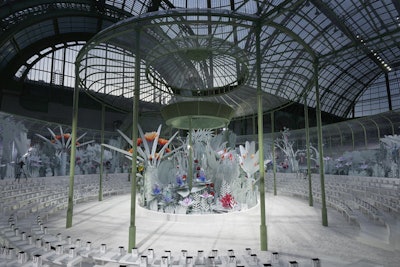
Inside the luxuriant greenhouse, Karl Lagerfeld delivered his ode to springtime. Guests sat in one large circular formation on tiered rows, flanked on both sides by the faux garden.
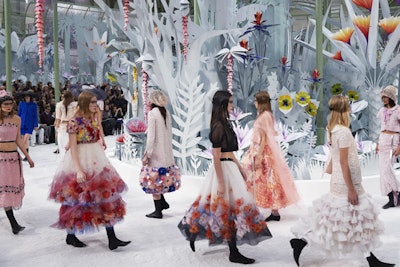
It took six months to make the 300 flowers that decorated the Chanel set. Each flower had its own "engine" and burst into full technicolor mechanical bloom after a model at the show's start applied a theatrical "splash" from a CC-branded watering can.
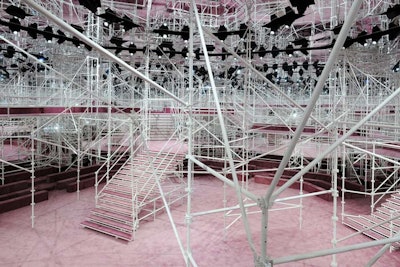
Held at the Musée Rodin venue that designer Raf Simons has utilized for the majority of his Dior shows, the January 26 Dior haute couture show, which had guests enter a stark white box, appeared deceivingly simple. Inside, however, the fully mirrored venue was revealed to be a spiral of glossy white metal scaffolding. Produced by Bureau Betak, the runway was a catwalk that snaked upwards in circles, with guests seated on multiple levels as the models paraded up and down on wall-to-wall soft pink carpeting.
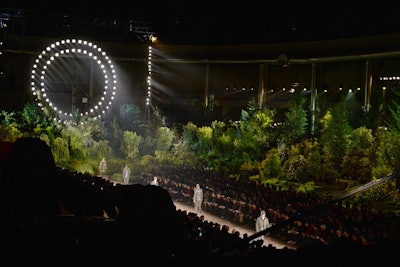
Stefano Pilati's January 17 menswear show for Ermenegildo Zegna was held at the CityLife Palace on the Piazza VI Febbraio (the site of Milan's former fairgrounds) in order to accommodate not only a sizable runway set, but to also seat as many as 1,000 guests. Urban Production oversaw the undertaking, which featured nearly two dozen different species of plants, including aucuba, fern, oat grass, medlar trees, and viburnum thymus.
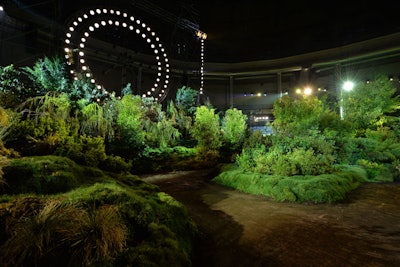
Massive mounds of earth surrounded a live deciduous forest, with a soundtrack of birdcalls and rolling thunder playing overhead that further accentuated the show's eco slant. The vegetation, inspired by Oasi Zegna, a company-funded reserve in the Biella Alps, will subsequently be replanted in the region's Biella mountains.
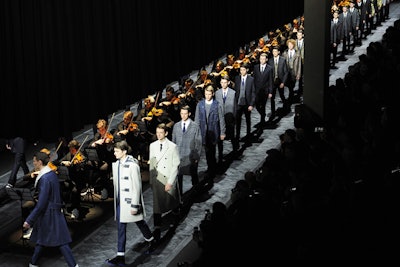
For designer Kris Van Assche's fall 2015 Dior Homme show on January 24, the designer shrouded the Tennis Club on the Périphérique in Paris in darkness, with a floor-to-ceiling black curtain guarded by security. As the show commenced, the curtain lifted slowly to reveal an orchestra of more than 30 members lining the full length of the runway. For the theatrical moment, all the musicians, who played a specially commissioned version of Koudlam's "The Landscapes," were clad in Dior Homme—a fitting complement to the show's emphasis on formal evening wear.
